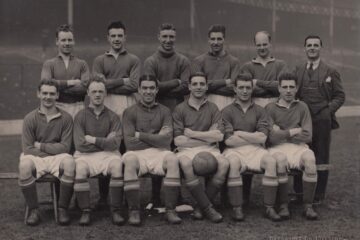
Clarence Herbert Berry was the first man to sign for Everton having previously played Rugby League football at senior level. He was born on 4 October 1886, and was the fourth child of Frank and Alice who ran a grocery business on Buick Street in Warrington.
Berry had begun to serve an apprenticeship as a pattern maker when he began his football career playing under association rules for a local amateur team with the name of Warrington Albion. He then switched codes and signed for Warrington Rugby League club at their Wilderspool home. Clarence Berry made his debut on 25 February 1905 in a home game against Swinton, where his second half penalty kick won the game. He made another six appearances, but was not selected to face Hull Kingston Rovers in the Rugby League Cup Final at Leeds. Warrington lifted the trophy for the first time with a 6-0 victory. During the next two seasons, Berry made over forty first team appearances, but once again failed to appear in 1907 Cup Final as Warrington beat Oldham, 17-3, on the Wheater’s Field home of Broughton Rangers in Salford.
He then decided to switch codes and approached Everton. After a trial period, he made his debut on 25 February 1908, keeping goal at Goodison Park in a Lancashire Combination game against St Helens Town which Everton won five goals to one. When the club executive met on 18 March, the following words appeared in the club minute book: ‘The Secretary was instructed to offer Berry an engagement on the best possible terms.’


Berry was at first reluctant take up lodging in Liverpool – as demanded in his contract – but agreed to do so on 23 September 1908 and signed for a wage of £3 per week. Nevertheless, the first choice in goal was Irishman Billy Scott, and Berry had to wait to make his Football League debut until Scott was called up for international duty . His first appearance occurred on 13 February 1909, in a 2-2 draw with Bury at Gigg Lane. He again deputised for Scott on 20 March when Chelsea visited Goodison Park. Everton beat the Londoners for the first time by three goals to two. Berry remained at Everton until 1912 during which time he made one more Football League appearance on 10 February 1912, in a 3-2 home win over Sheffield United. The following week he was put on the transfer list for an asking price £300.

The Everton minute book records that the club were about to sign William Hodge from Kilwinning Rangers, along with John Caldwell, who was at that time under contract with Tottenham Hotspur. Clarence Berry remained in the reserve pool of players but, as the season reached its conclusion, the price of his transfer had dropped to £150. He did, however, represent the senior XI on one further occasion. Early on 30 March the Everton party assembled at Fleetwood in order to catch the ferry to play a match against Linfield in Belfast. Berry – despite being selected to play against Northern Nomads – was ordered post-haste to join the party when it became known that Billy Scott would not be sailing. (The reason given was ptomaine poisoning). The game, which took place at Windsor Park, ended in 0-0 draw.

When his contract expired, Berry returned home and signed for Lancashire Combination side St Helens Town. He remained there for one season before ending his career playing the rugby code for Warrington. During his time with Everto,n Clarence Berry had married Elizabeth Oakes, and the 1911 census found the couple living at 24 Sutton Street in Warrington. He listed his occupation as that of a pattern maker and not a professional footballer.
They later moved to 359 Thelwall New Road, in the Grappenhall area of Warrington and became members of congregation the local Baptist church. Clarence Berry lived at this address until his death on 8 October 1954 and was buried in the cemetery at Hill Cliffe Baptist Church in Warrington.
Acknowledgements
Neil Dowson, Warrington RLFC.
Chris Hudson, Hill Cliffe Baptist Church, Warrington.



